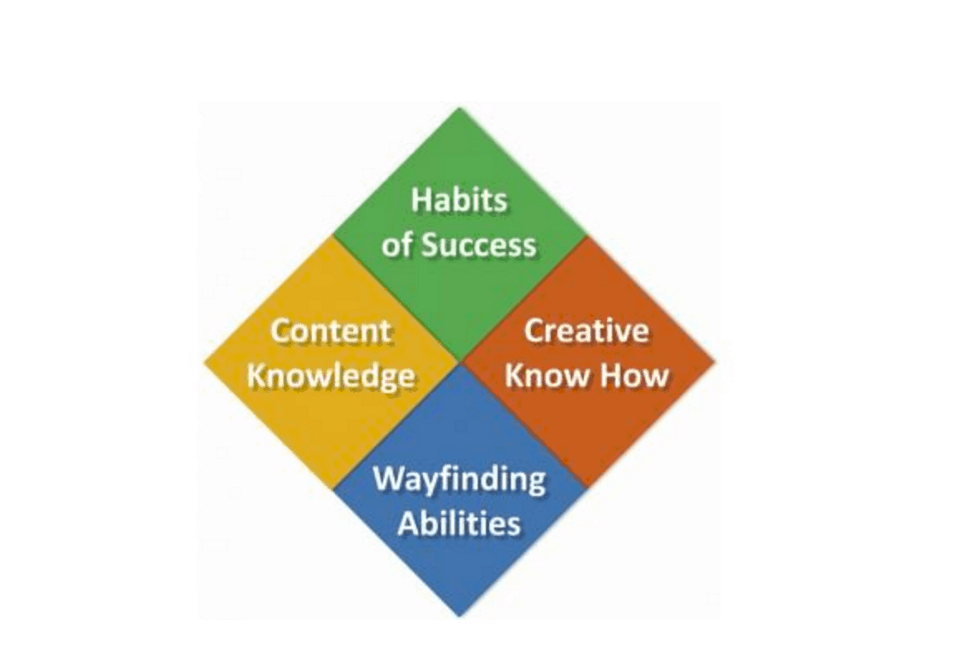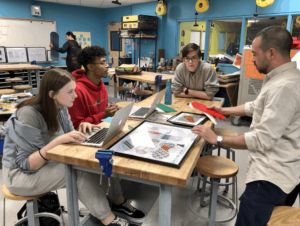Rethinking High School Graduation Requirements: Project & Microcredentials

For a century the high school finish line has been a list of courses and credits.
The table below is the actual Committee of Ten recommendations from a second printing of the report in 1894. It illustrates the number of weeks devoted to each subject in a given school year.

Just google graduation requirements for your state and you’re likely to find a table that looks quite similar–with a few exceptions.
The five states that make up the New England Secondary School Consortium have made progress on redefining success by developing proficiency-based diplomas. Maine expects students to be proficient in a set of eight domains and the guiding principles. Vermont’s proficiency-based requirements have seven domains and what they refer to as transferable skills (see CompetencyWorks for more).
Chris Sturgis notes that many schools use capstone projects, exhibitions or portfolios that provide evidence that students have met the level of proficiency. In many cases, students are asked to present to an audience of community members, peers, parents and teachers. (Chugach School District has very clear set of graduation expectations in each domain, see page 35 in the Implementation report.)
In post-NCBL land there’s an opportunity for states and districts to reconsider readiness. The superintendent’s association is leading an initiative called #RedefiningReady that is considering broader measures for college, career and life readiness. This opportunity builds on all that we’ve learned about:
- Building Habits of Success and Measuring What Matters
- Creating Next Generation Schools
- Personalized, Project-Based Learning
- The Shift to Competency-Based Learning
Given all this opportunity how do we reconceptualize what graduates should know and be able to do?
Houston and Marion, OH, are examples of districts that have recently described a graduate profile. Summit Public Schools and Next Generation Learning Challenges both built on David Conley’s Think-Know-Act-Go framework to construct a graduate profile.
Experiencing Success, Demonstrating Mastery
Another way to frame and communicate learning expectations is to ask students to complete and present 20 projects (or, more broadly successful learning experiences) — four to six per year over three or four years including:
- Solve a local problem (community service)
- Launch a business or sustainable initiative (entrepreneurship)
- Build a mobile app (for the business/initiative)
- Secure and serve a customer with marketing services
- Share a global context (comparative analysis across time/subjects)
- Propose solutions to 3 global problems (see case for studying UN’s #GlobalGoals)
- Complete an online course
- Complete 2 college courses
- Demonstrate computational thinking
- Demonstrate application of data analysis
- Conduct a science experiment and publish the results
- Publish 40 editorials, reviews, or reflections (individual)
- Publish 2 major works: papers, books, or sites (team)
- Explain 10 emerging implications of artificial intelligence on lives/livelihoods
- Produce and present public art (performance, exhibit)
- Apply to a valuable postsecondary experience (college or equal)
Some of these projects/experiences could be team and some individual. They would all help develop and demonstrate 10 important success skills:
- Self-directed learners
- Skilled communicators
- Design thinkers
- Persistent innovators
- Data & AI literate
- Empathetic collaborators
- Resourceful problem solvers & entrepreneurs
- Global citizens
- Experienced project managers
- Healthy conscientious neighbors
Demonstration of these skills and dispositions could be recorded as a series of microcredentials.
If graduation requirements were described as 20 projects and 10 microcredentials it would allow students to attack the requirements in their own way and at their own pace often working in teams and cohorts.
Key to this system would be sustained relationship with skilled advisors that could help construct projects mapped to important skills.
We need more experimental school models that combine innovative pedagogy, new outcome constructs and powerful tools that enable a powerful sequence of learning experiences.
For more see
- One Stone Launching Innovative New High School in Boise
- Open a Microschool, Here’s How
- 66 Middle and High Schools Worth Visiting
Stay in-the-know with all things EdTech and innovations in learning by signing up to receive the weekly Smart Update.







Chester Kirkhope
Hi gettingsmart.com admin, You always provide useful tips and best practices.